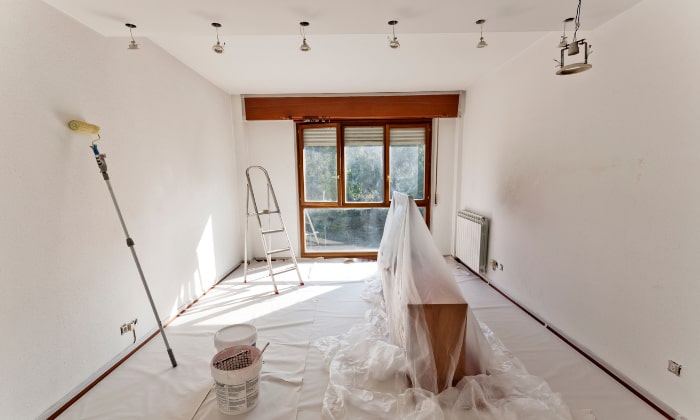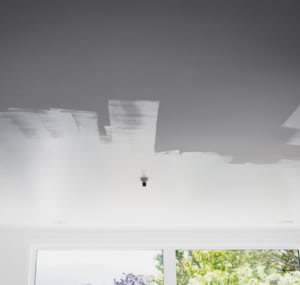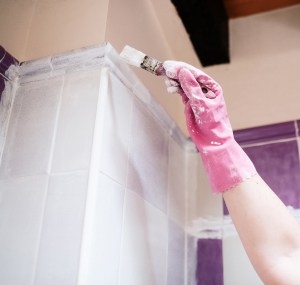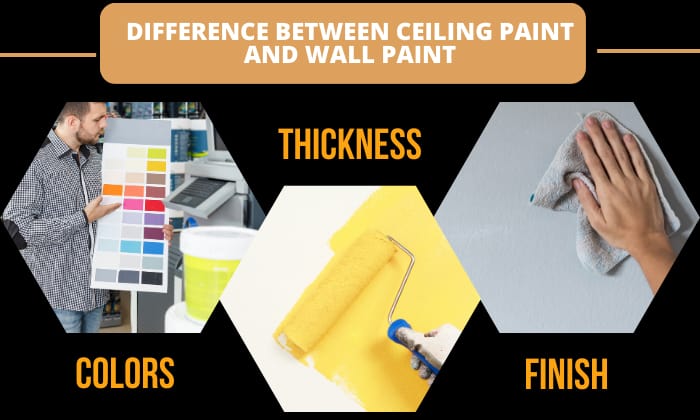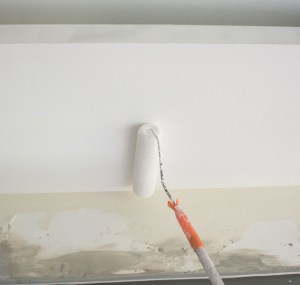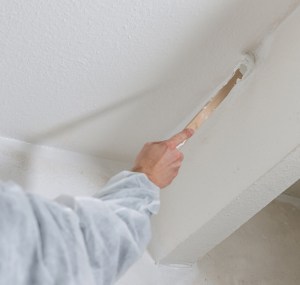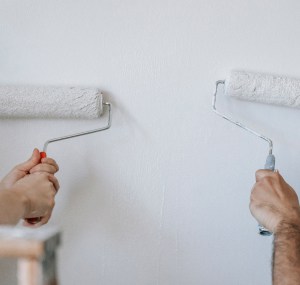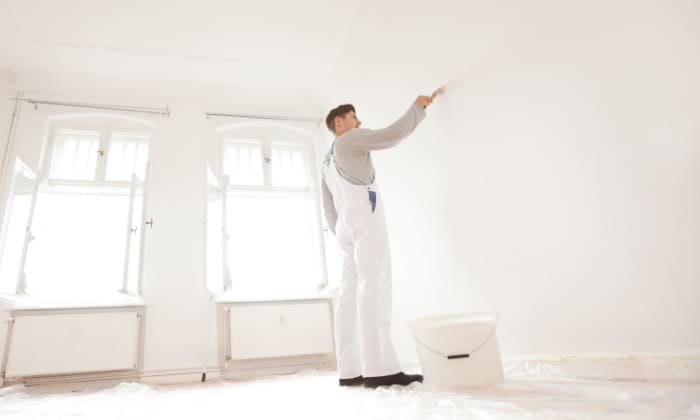Generally, when painting walls, most people opt for wall paints. However, in some instances, ceiling paint may come in handy. The question is, can you use ceiling paint on walls?
The answer is yes! You can paint walls with ceiling paint to bring uniform, durable, and professional-looking results while being cost-effective. Read on to understand its difference from wall paints and the when and how of using ceiling paint on walls.
Table of Contents
You Can Use Ceiling Paint on Walls
Do you often question whether ceiling paint can be used on walls? In reality, there are no rules to hinder the use of ceiling paint on any surface. However, experts generally recommend using specific paints for designated areas to optimize their effectiveness.
Here are the types of ceiling paint that can be used on ceilings, walls, doors, and other places in the house:
1. Flat acrylic ceiling paints
Flat acrylic ceiling paint is popular for ceilings because of its bright white. Its thick viscosity makes it easy to apply and is excellent for hiding bumps, dents, or imperfections in ceilings.
This type of paint also has a low sheen which doesn’t reflect light as much as other finishes.
However, because flat acrylic paints are less reflective, they can be more susceptible to scuff marks or stains.
Also, this type of paint is never recommended for rooms with high moisture and humidity content, as it could chip or peel in no time.
2. Semi-gloss ceiling paints
Semi-gloss finish ceiling paint has a higher sheen than flat acrylic ceiling paint. It provides more reflectivity, which makes the room brighter.
Semi-gloss finish also offers excellent durability and is resistant to scuffs and stains. Hence, it is recommended for bathrooms where moisture and humidity reside.
Moreover, a semi-gloss finish is ideal for high-traffic areas such as hallways or children’s bedrooms.
However, because it reflects more light, it can highlight any imperfections in the wall surfaces, such as dents or scratches.
Where to Use Ceiling Paint Aside From Ceilings
1. Interior walls
One of the clever hacks in painting is to use ceiling paint on walls as a primer. Ceiling paints possess similar characteristics to primer, providing a sealing and protective layer for walls.
Hence, if you have leftover ceiling paint, instead of discarding it, put it to good use by applying it to your walls.
2. Bathroom
Bathrooms are notoriously high-moisture areas due to the presence of humidity and water. Thus, it requires resilient paint that can endure dampness and withstand frequent exposure to water and cleaning substances.
This is precisely why ceiling paint can be used on bathroom walls, as it can withstand the prolonged presence of water. Its durability and consistency provide additional protection for walls against damage from molds caused by moisture.
3. Closet
Closets are areas that remain closed most of the time. As a result, they do not typically require specialized paint. Opting for white ceiling paint in closets can provide a clean and unobtrusive look, allowing for clear visibility of items stored inside.
Additionally, the light properties of the paint can help brighten the interior, making it easier to locate specific clothing items.
4. Doors
You can certainly use ceiling paint on doors as a primer. It adheres well on wood and helps hide stains, unwanted dents, or other imperfections on the door surface.
However, it is not advisable to use ceiling paint as a finish in this area as it might end with an unfavorable aesthetic view in no time.
Remember that ceiling paints are not glossy enough to repeal the collection of dust; hence they should be top coated with glossier paint to make the cleaning and maintenance easier, especially when placed in a high-traffic area.
Why Use Ceiling Paint on Walls?
According to our research, some of the ultimate reasons for using ceiling paint on walls are:
- Ease of Application
On the other hand, ceiling paints are typically formulated with more solids in them. These solids help reduce drips and splatters during the paint application which helps avoid the mess in the process.
- Uniform Appearance
Choosing the same paint for the ceiling and walls can be unique. It brings a uniform look and seamless appearance throughout the room. Also, this style eliminates visual distractions such that wall decors, paintings, and furniture stand out.
- Eliminate Brush and Roller Marks
Ceiling paints are designed to dry slowly. It allows more time to work on the paint and achieve a smooth finish. This slow-drying property helps prevent lap marks from the brush and roller. It also minimizes other imperfections that occur when painting walls with fast-drying paint.
- Block Stains
The presence of more resin and polymer on ceiling paint blocks stains perfectly from smoke and watermarks. That said, it is pleasant for children’s rooms and other parts of the house that are exposed to said elements.
- Mold Resistant
Most ceiling paint brands continuously evolve and address the mold problem. Manufacturers infused mold and mildew-resistant properties on their paint to prevent the growth of molds in places where they are applied.
Difference Between Ceiling Paint and Wall Paint
| Differences Between Ceiling Paint and Wall Paint | Ceiling Paints | Wall Paints |
| Color | Limited color selection | Infinite color selection |
| Coverage | A single layer can be enough | 2 or 3 layers are needed. |
| Durability | Durable | Less durable |
| Finish | Flat, semi-gloss – limited | Matte, satin, eggshell, semi-gloss, high gloss – more possibilities |
| Viscosity | High viscous (thick consistency) | Low viscous (thin) |
| Price | Less expensive | Expensive |
The main difference between ceiling paint and wall paint boils down to color selection, coverage, durability, sheen, viscosity, and price.
- Colors
Ceiling paint has limited colors to choose from. The commonly used ceiling paints are white or off-white. Meanwhile, wall paint has all colors of the rainbow, its corresponding shades and tints are present in the color selection of wall paint.
- Thickness
However, when applied on surfaces, ceiling paint can cover stains and watermarks with only one layer of paint. Thanks to the thicker consistency it possesses. Compared to ceiling paint, wall paint applies two or three layers to fully cover stains since their composition is thinner and more liquid.
- Finish
Moreover, though ceiling paints have a limited number of finishes compared to wall paints, they are exclusively formulated to withstand the wear and tear caused by moisture and humidity. Their durability resists scuffing, fading, and chalking better than wall paints.
When to Use Ceiling Paint on Walls
Ceiling paints cannot be used on walls or other things in the house as long as you want. Certain situations make it appropriate to use ceiling paint; some of them are when:
- Faced with unwanted traces of cooking splatters, cigarette smoke, and children’s handprints or doodles on walls
- Permanent stains and watermarks are present on walls
- Wooden wall grazes, scrapes, and pet scratches which make the wall surface uneven
- Accent designs on walls
Ceiling paint conceals all the abovementioned imperfections on walls, makes the surface as smooth and flat as possible, and provides stain protection afterward. Aside from this, using ceiling paint on wall accents brings leftovers into good use while bringing another charm to dull walls.
How to Use Ceiling Paint on Walls
1. Prepare the surface
To begin, clean the surface of the wall with a damp cloth or sponge. Make sure to remove dirt, dust, and any other debris as these cause unevenness in the finish.
If there are any deep scratches or holes on the walls, fill them with spackling compound, after which let the wall surface dry completely before proceeding with the next step.
2. Priming proper
Begin by priming your walls using a high-quality primer compatible with ceiling paint. Follow the manufacturer’s guidelines and written drying time as this affects the overall outcome.
3. Paint the ceiling
When you paint the ceiling and wall at the same time for uniformity, paint the ceiling first and then, work your way down the trims and walls.
4. Cut-in corners
While painting the ceiling, there are great chances that the innermost corners and edges where the wall and ceiling meet are not reached by roller. With this, take an angled brush and precisely paint the unreached areas.
5. Paint the walls
Lastly, paint the walls in small portions until all the surface is finished.
Frequently Asked Questions
Can I Mix Ceiling Paint with Wall Paint
Yes, you can mix ceiling paint with wall paint if the type and sheen of both paints are the same.
For instance, acrylic ceiling paint and acrylic wall paint with a matte finish can be mixed. Flat ceiling paint and semi-gloss wall paint can be mixed however the sheen degrades following the proportion of the mixture.
On the other hand, ceiling paint and wall paint with different base types should never be mixed!
Example of base type is an oil-based and water-based paint. Mixing both of these bases leads to detrimental effects like clumping of paints, separation of oil-based paint and water-based paint, and adhesion issues.
Can you use ceiling paint outside?
Yes. You can use ceiling paint outside when trapped in a tight budget situation.
However, it is not recommended. Even though ceiling paints have durable properties, their resin is not flexible enough to withstand different and extreme weather conditions.
Conclusion
Using ceiling paint on walls is possible if done correctly with proper preparations. The right type of ceiling paint can bring professional results to the wall surface and can be an affordable paint solution to beautify walls too.
Understanding the differences between both paints gives you a definite answer to the question: can you use ceiling paint on walls? So, the next time you consider painting your home’s space, don’t overlook using ceiling paint on walls. It may just surprise you with how well it works!

Hi, I am Roseanne Jones, an aspiring home designer that wants to make you feel more at home with your new house.With nearly five years of redecorating old residents and arranging new ones, I am confident that I can give you the best advice on your lovely place.



